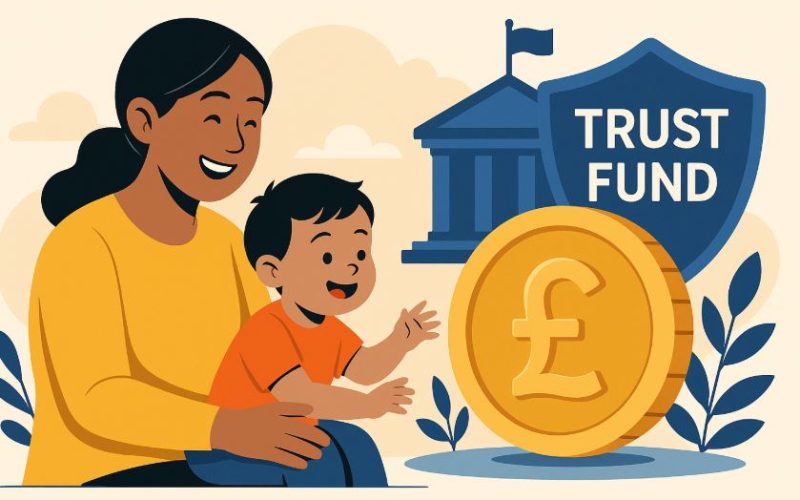Were you born between 2002 and 2011? You may be entitled to money from a Government Child Trust Fund (CTF). Many young adults turning 18 today are discovering they have hundreds, or even thousands, saved in their name.
But how much could you actually receive from the initial £250 contribution? In this guide, we explore everything you need to know about your Child Trust Fund, from finding it to understanding its current value and using it wisely.
What Is the Government Child Trust Fund?

The Child Trust Fund (CTF) was a long-term tax-free savings account introduced by the UK Government for children born between 1 September 2002 and 2 January 2011.
Its main goal was to encourage parents and guardians to save for their children’s future in a structured way. The Government contributed a starting payment, and in some cases, additional funds, into the accounts of eligible children.
Each eligible child received a voucher to open a Child Trust Fund account. The standard payment was £250, while children from low-income families received an enhanced payment of £500.
In some cases, children born later in the scheme (particularly during its final months) may have received as little as £50. Regardless of the initial amount, the funds could grow over time depending on how they were managed.
The Child Trust Fund scheme officially closed in 2011, meaning no new accounts can be opened today. However, parents and guardians can still contribute up to £9,000 annually into existing accounts.
Importantly, you cannot hold both a Child Trust Fund and a Junior ISA for the same child. If you prefer the Junior ISA route, you must transfer your CTF into it.
Key Points
- Available to UK children born between 1 Sep 2002 and 2 Jan 2011
- Initial Government payments: £250 or £500
- The scheme closed in 2011
- Annual contributions up to £9,000 are still allowed
- Junior ISA option available by transfer only
How Much Was Initially Given – Was It Really £250 or More?
Many people assume that all children received £250, but in reality, the amount varied depending on household income and Government rules at the time of birth. Here’s how it typically broke down:
Initial Government Contributions Based on Eligibility
| Criteria | Initial Payment | Additional Payment (Age 7) |
| Standard households | £250 | £250 |
| Low-income households (means-tested) | £500 | £500 |
| Born during final 6 months of the scheme | £50 | £50 |
The Government provided a top-up of the same amount around a child’s 7th birthday, doubling the total contribution for many children.
However, not every child received this second payment. Whether your CTF received top-ups depends on specific policies in place during your child’s eligibility years.
The result is that some Child Trust Fund accounts received as much as £1,000 from the Government alone before any personal or family contributions were added.
Government Child Trust Fund £250 – How Much Will I Get Now?

The big question for many young adults turning 18 today is: How much is my Child Trust Fund worth now? The answer isn’t the same for everyone. Although the initial deposit may have been £250 or £500, the current value of the account depends on several factors.
Factors That Affect Current CTF Value
- Type of Account: Cash or investment-based
- Additional Contributions: From parents, family, or friends
- Account Performance: Especially for investment CTFs
- Account Fees: May vary by provider
Estimated CTF Value in 2025 Based on HMRC Data
| Account Type | Initial Government Only | With Some Contributions | With Regular Contributions |
| Cash CTF | £300 – £900 | £1,000 – £2,000 | £3,000 – £6,000 |
| Investment CTF | £400 – £1,200 | £1,500 – £3,000 | £4,000 – £8,000+ |
According to HMRC, the average balance in matured CTFs as of 2025 is around £2,212. However, some accounts, especially investment-based ones, have grown significantly higher.
If you’re unsure of your balance, you won’t be able to check it through HMRC. Instead, you must contact your CTF provider directly.
What Happens to a Child Trust Fund When You Turn 18?
Once the account holder turns 18, the Child Trust Fund matures, and the money becomes legally theirs to control. The account does not disappear or vanish, even if no action is taken. Instead, the provider automatically converts the CTF into an adult equivalent.
Possible Conversions After Age 18
- Cash CTF: Converts into an adult cash ISA
- Investment CTF: Converts into an adult stocks and shares ISA
If the provider is no longer authorised to manage ISAs, the funds are transferred to a protected HMRC account, which preserves the tax-free status but limits access until action is taken.
You are under no obligation to withdraw the funds immediately, and there is no deadline to claim the money. However, providers may not offer the best interest or growth options for matured accounts.
It’s wise to review your options and decide how to manage or reinvest the money for better growth or utility.
Can You Still Add Money to Your Child Trust Fund Today?
Yes, even though the scheme is closed to new applicants, existing Child Trust Fund accounts remain active and can receive contributions. You can pay in up to £9,000 per year, tax-free. This annual allowance resets every tax year.
Contribution Guidelines
- Only the child (once 16 or older) or parent/guardian can manage contributions
- Anyone can add funds (relatives, friends), but the total must not exceed the £9,000 limit
- Contributions do not affect benefit entitlements
This flexibility allows families to use the CTF as a long-term saving strategy until the child turns 18. After that, they can either continue saving through an ISA or use the funds for other purposes.
How Do I Find Out Where My Child Trust Fund Is Held?

If you’re unsure where your Child Trust Fund is located, you’re not alone. Many young adults have lost track of their accounts. Fortunately, there are tools available to help locate your fund.
Finding Your Provider
You can ask your parent or guardian if they remember which bank or provider the account was opened with. If that doesn’t work, use the HMRC Child Trust Fund Finder Tool, which is available online.
To use it, you will need:
- Your National Insurance Number
- Your full name and date of birth
If you’re a parent or guardian trying to find a fund for your child under 18, you’ll need to provide:
- The child’s full name, date of birth, and address
- Any previous names used
- The child’s National Insurance number (if available)
If you apply online, you’ll usually receive a response from HMRC within three weeks. Postal requests may take up to six weeks.
What Determines the Current Value of a Child Trust Fund?
The value of your Child Trust Fund today is shaped by several financial and administrative factors. Even two children who received the same initial payment may see drastically different balances depending on how the money was managed.
Key Influences on Growth
- Cash vs. Investment Accounts: Investment accounts generally perform better over time, especially in strong markets. However, they also carry more risk.
- Top-Ups and Contributions: Regular contributions from family, especially in early years, significantly compound over time.
- Duration of Account Activity: The longer the account has been active without withdrawals, the more time it had to grow.
- Account Fees: Some providers charge management fees, which can reduce overall returns over time.
Understanding how your fund was managed over the years is essential to understanding its current value.
Is It Better to Leave the Fund or Transfer It to a Junior ISA?
Although you can’t open both a CTF and a Junior ISA, you can transfer your existing Child Trust Fund into a Junior ISA if you prefer better rates or more flexible options.
Reasons to Transfer to a Junior ISA
- Better interest rates
- More investment choices
- Easier account management with modern platforms
If you’re under 18 and your fund hasn’t matured yet, this could be a good time to review your provider’s rates. Transferring may unlock higher savings growth before the account matures.
However, once you turn 18, you’ll need to compare adult ISAs for long-term growth or flexible withdrawals.
What Should You Do With the Money Once the Fund Matures?

Turning 18 and unlocking your Child Trust Fund gives you several financial choices. What you decide to do depends on your current needs and long-term goals.
Best Uses for CTF Money at Age 18
- Move to a high-interest savings account if you’re unsure what to do next
- Use for university or college expenses
- Invest in a Lifetime ISA to save for a first home with a 25% government bonus
- Invest in stocks or ETFs for long-term growth (but be aware of risks)
- Use it to purchase essential items like a laptop, car or training courses
- Pay off high-interest debts if you’ve already taken on borrowing
Your CTF gives you a financial head start. Using it wisely can shape your financial health for years to come.
Can You Use the Child Trust Fund for a First Home or Investment?
Yes, you can use your matured Child Trust Fund to invest or support a property purchase, but it must first be transferred into an appropriate ISA product to take full advantage of tax-free benefits and government incentives.
Using CTF for a First Home
If you open a Lifetime ISA (between ages 18 and 39), you can transfer up to £4,000 per year and receive a 25% bonus from the Government (up to £1,000 per year). These funds can be used toward buying your first home valued up to £450,000.
Investing the Funds
If you’re comfortable with taking some risk, consider transferring your matured CTF into a stocks and shares ISA. Over the long term, investments tend to outperform cash savings.
Always seek financial advice or use low-cost platforms if you’re a beginner. Investing isn’t for everyone, but it can be a powerful way to grow your savings.
Conclusion
The Government Child Trust Fund scheme may have ended in 2011, but for thousands of young adults in 2025, the benefits are just beginning to be felt.
Whether you received the standard £250 or a higher amount based on your family’s income, your fund could now be worth a substantial amount, especially if it was invested or topped up over time.
If you’re turning 18 and wondering what to do with your matured account, take your time to explore the options. Whether you want to save, invest, or spend it wisely, the key is to make an active decision that aligns with your goals.
Understanding the value of your Child Trust Fund and how to access or grow it can be a strong first step toward your financial independence.
Frequently Asked Questions
Can I withdraw my Child Trust Fund money before I’m 18?
No, you can only access your Child Trust Fund once you turn 18. However, you can take control of the account at age 16.
How do I know if I have a Child Trust Fund?
If you were born in the UK between 1 September 2002 and 2 January 2011, you likely have a CTF. Use the HMRC tool to find out.
What if I don’t remember where my account was opened?
You can contact HMRC using your National Insurance number to trace your Child Trust Fund provider.
Does the fund expire if I don’t claim it at 18?
No, the money remains yours indefinitely. However, the account may stop earning good interest if left unattended.
Can I transfer my CTF into an adult ISA?
Yes, once you turn 18, the fund automatically converts into an adult ISA. You can then switch it to another provider if needed.
Is the Child Trust Fund money taxed when withdrawn?
No, the Child Trust Fund is tax-free, and there’s no tax when you withdraw or use the funds.
What happens if my provider no longer offers ISAs?
In that case, the fund will be moved to an HMRC-protected account where it maintains tax-free status until you take action.









